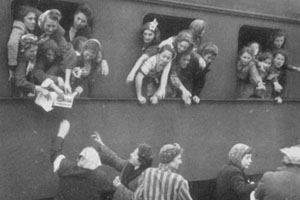






Click on the grey arrow (<) to start the exhibition over again
Click on the grey arrow (>) to continue in the exhibition to artefact pictures
backgrounds /
the White Buses







In February 1945, Count Folke Bernadotte went to Germany to negotiate with SS Reichsführer Himmler, who was in charge of all the concentration camps, the release of the Scandinavian prisoners in the camps.
In due course, the negotiations started to be successful and the Swedes organized a substantial rescue organization. Red Cross in close cooperation with the Swedish Defense, which provided staff and vehicles such as buses and trucks, supervised the operation.
In the beginning of March 1945, the first buses boarded a ferry from Malmö to Copenhagen. The buses were painted with camouflage colors, and marked with red crosses and Swedish flags on the sides and roofs. But then an order came from the allies that the buses had to be painted white, so they could distinguish them from enemy vehicles. When the order came, there were already a few buses aboard the ferry bound for Copenhagen.
“At this point all painters in Malmö were mobilized with buckets and brushes to paint fervently the whole night long. Even as the ferry was about to depart there were still a few buses left to paint, but the jovial painters settled the problem by going along to Copenhagen to finish the job.”
/Åke Svenson/
During new dialogues with Himmler, Folke Bernadotte managed to get approval to take non-Scandinavian prisoners from Ravensbrück and other camps to Sweden with the White Buses. Some also arrived with train and boat.
An estimated 30,000 refugees arrived in southern Sweden.
Sten Olsson was on 10 trips with the White Buses. Below he recounts some of his memories.
“What was I doing when the war broke out? I worked at a car repair shop in Klippan. It was there that I heard about the White Buses and I was asked. Actually, it wasn’t me they asked, but a coworker, but he didn’t want go, since he was married.
I was 24, a grown man, but without a family of my own. I had only my parents and siblings. Since my coworker didn’t want to go, I asked if I could go instead. That’s how it went. I was asked three thirty in the afternoon and I stood by my word. Of course I did. They wanted me to go to Hässleholm at once, but I said that I had to bicycle home and tell my parents what I was going to do.
The next morning at eight o’clock , I bought my ticket at the little station at Gråmanstorp outside Klippan.
In Hässleholm, we were equipped, vaccinated, and photographed. And we needed passports and visas. Then we got a little driving practice. We went to a little lecture about how we should behave. Then we left. I think it was on March 10, 1945...
...continues...
...I made about ten trips. There were those who did more and those who made shorter trips. But I was on the trip to Mathausen. It took about ten days. First, they wouldn’t release any of the prisoners at Mathausen, so we went to Dachau , and then back to Mathausen again. It was very difficult because the roads were full with people fleeing the Russians. Suddenly, you would wind up behind a car towed by a cow. They had no gas. We called these contraptions ‘crate wagons’. They would be full of starving children.
It took a long time to get there. Sometimes at night, we went up to 80-90 kph on the highway. We hardly had headlights. We covered them with camouflage, so the light was dim. We wouldn’t be alive today, if we had had the lights on. The British were in the air all the time and if they had seen our lights they would have shot at us directly. They couldn’t see the cross on the bus at night...
...continues...
...During the day, it was not as dangerous since they could see the crosses. We could be in a convoy of ten buses. Sometimes, a German vehicle tried to squeeze in among us. They thought they were safe there. But the British could dive down in front of the bus to shoot at a car. They were very good at that. We saw when the planes attacked. On the autobahn, next to the road, there were bloated horse carcasses. They do get like that. It was horrible. Germans came and took pieces, if they got to it.”
/From an interview with Sten Olsson,
Klippan, June 2001/

introduction
Ravensbrück, the camp
the White Buses
reception in Sweden
Lakocinski
collecting artifacts
the artifacts
Click on the blue headlines to read background texts
Click on the questionmark (?) for info and orientation in the exhibition